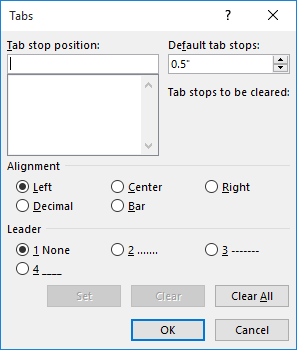Please Note: This article is written for users of the following Microsoft Word versions: 2007, 2010, 2013, 2016, 2019, and 2021. If you are using an earlier version (Word 2003 or earlier), this tip may not work for you. For a version of this tip written specifically for earlier versions of Word, click here: Setting Tab Stops Using the Tabs Dialog Box.
Written by Allen Wyatt (last updated September 7, 2023)
This tip applies to Word 2007, 2010, 2013, 2016, 2019, and 2021
Tab stops allow you to quickly and accurately align information on a line in your document. If you are familiar with typewriters, then you are already familiar with the concept of tab stops. Word goes far beyond the rudimentary tab stops in typewriters, however. It allows you to set four different types of tab stop:
| Type | Effect | |
|---|---|---|
| Center | Text entered after pressing the Tab key is horizontally centered on the position where the tab stop is located. | |
| Decimal | Text entered after pressing the Tab key is horizontally aligned so the decimal point (or period) is where the tab stop is located. If there is no decimal point, text is right-aligned to the tab stop. | |
| Left | Text entered after pressing the Tab key is horizontally aligned so the left side of the text is where the tab stop is located. | |
| Right | Text entered after pressing the Tab key is horizontally aligned so the right side of the text is where the tab stop is located. |
Word provides two major ways to set tab stops. One involves using the ruler, which is best deferred to a different tip. The other involves using the Tabs dialog box. To set tab stops using this method, use the following steps:

Figure 1. The Tabs dialog box.
You may have noticed from examining the Tabs dialog box that there is also a tab alignment type known as Bar. This is not really a tab stop at all, but a way to place a vertical bar at a particular location in your paragraph. In fact, referring to Bar as an alignment type is a misnomer because no text is aligned at all.
WordTips is your source for cost-effective Microsoft Word training. (Microsoft Word is the most popular word processing software in the world.) This tip (8257) applies to Microsoft Word 2007, 2010, 2013, 2016, 2019, and 2021. You can find a version of this tip for the older menu interface of Word here: Setting Tab Stops Using the Tabs Dialog Box.

Create Custom Apps with VBA! Discover how to extend the capabilities of Office 365 applications with VBA programming. Written in clear terms and understandable language, the book includes systematic tutorials and contains both intermediate and advanced content for experienced VB developers. Designed to be comprehensive, the book addresses not just one Office application, but the entire Office suite. Check out Mastering VBA for Microsoft Office 365 today!
Adding dot leaders to your text is easy through the application of tab stops. This tip explains the steps you need to ...
Discover MoreIf you have a constant need to define tabs at the edge of the right margin, you'll love the macro-based technique ...
Discover MoreNeed to delete some tabs tops in a paragraph? It's easy to do using the Tabs dialog box, as described in this tip.
Discover MoreFREE SERVICE: Get tips like this every week in WordTips, a free productivity newsletter. Enter your address and click "Subscribe."
2020-05-08 16:54:32
Lynette J Ford
I am a hard ti.e setting ta s stops frustrating .
Got a version of Word that uses the ribbon interface (Word 2007 or later)? This site is for you! If you use an earlier version of Word, visit our WordTips site focusing on the menu interface.
Visit the WordTips channel on YouTube
FREE SERVICE: Get tips like this every week in WordTips, a free productivity newsletter. Enter your address and click "Subscribe."
Copyright © 2026 Sharon Parq Associates, Inc.
Comments